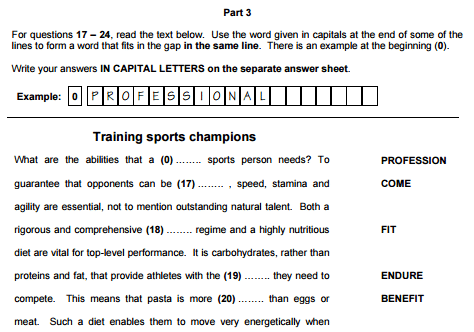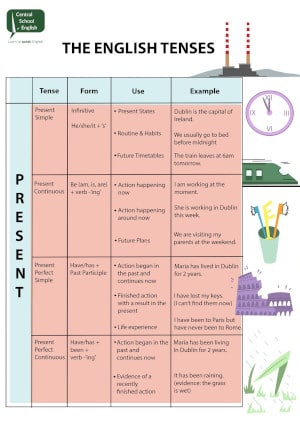CAE Exam Class – Reading and Use of English Part 3

This CAE Exam class looks at the third part of the Reading and Use of English Paper in the Cambridge Advanced (C1) Exam, what it tests, how to approach it and how to revise for it.
The third test in the Reading and Use of English Paper of the CAE Exam looks something like this:

(The actual test paper is longer with 8 gaps for you to fill.)
What the test involves
Part 3 is similar in some ways to Part 1 in that it is a vocabulary exercise (Part 2 really focuses on grammar). However, rather than being a multiple choice exercise, Part 3 features a gapped text and at the end of each gapped line there is a base word which you must use – you have to change this base word into the correct form to complete the sentence. Simple!
Time you should spend on this test.
Approximately 5 minutes.
What’s being tested
This is a test of vocabulary and word formation.
How to do the test
1. Read the title
This will give you an idea of what the text is about. This is helpful to know because the more you understand the context, the easier some of the answers will be.
2. Skim through the text
Quickly read through the text to give yourself even more of an understanding of the context.
3. Look at the BASE WORDS (at the ends of the lines)
Read the base words you will need to use and think about what part of speech each one is. Is it a noun, a verb, an adjective, or an adverb? Bear in mind that some words might actually be more than one type of word – for example “BENEFIT” (question 20 in the above example) could be a noun or a verb.
4. Read through the text more slowly
Read the text more slowly and look at the words that come before and after each gap. What part of speech are these words? Once you know what kinds of words these are you can start to think about the type of word you will need to put into the gap. If you’re not sure of an answer you can move on and come back to it later. But remember, you don’t lose points if you write an incorrect answer, but you’ll definitely get zero if you write nothing!
Answering the questions
-
- What kind of word do you need to fill the gap? A noun, a verb, an adjective, or an adverb? You can only write ONE word in each gap – and you MUST change the base word in some way.
- If you need a NOUN, you will need to consider whether it should be singular or plural. Look out for any verbs in the sentence as they will give you a clue. The articles can also help you – the indefinite article “a/an” can only be used with singular countable nouns. The zero article (when we actually don’t use an article) is used with uncountable nouns or plural countable nouns. The definite article “the” can be used with any type of noun so actually doesn’t really help us that much. It’s also worth remembering that some nouns can have positive and negative forms (possibility – impossibility).
- If you need an ADJECTIVE or an ADVERB, you need to consider whether it should be in a positive or a negative form. If you read the whole sentence, or even better the whole paragraph/text, and understand the context then it should become clear.
- If you need a VERB, there are only five different possibilities that it could be. Because you can only put ONE word into each gap, the only verb forms that you can use are:
- The infinitive without “to”
- Present Simple (which might be the same as the infinitive without “to”)
- Past Simple
- Past Participle
- Present Participle/Gerund (the “-ing” form of the verb)
Every other verb form or tense in English actually needs more than one word – an auxiliary verb and a main verb, for example.
- Another thing to consider with VERBS is Prefixes. Verbs in the Advanced often need to have a prefix added to give the verb a special meaning. For example, the prefix “mis-“ which means “wrongly/badly” – understand/misunderstand.
Scoring
You will get one mark for each correct answer.
CAE Exam Class: Reading and Use of English Part 3 – An Example

(The actual test paper is longer with 8 gaps for you to fill.)
Let’s look at the example above (number 0).
The sentence says, “What are the abilities that a _____ sports person needs?” and our base word to use is “PROFESSION”. If we look at the words before and after the gap with have the indefinite article “a” and after the gap we have a noun phrase “sports person”.
So, we need to use a word that can go between an article and a noun/noun phrase… an adjective! The adjective form of the noun “PROFESSION” is “PROFESSIONAL” and so that’s the answer.
Let’s try the first actual question as well (17).
Our base word is “COME” which is a verb. The sentence reads “To guarantee that opponents can be ________, speed, stamina and agility are essential, not to mention outstanding natural talent.”
So, let’s look at what we have before and after the gap. Before we have the modal verb phrase “CAN BE” and after the gap we have a comma, so we could consider the sentence to end here. We need to think about what could follow the verb “BE”. Our text is about professional sports people – sports people compete against their opponents – so maybe we need the sentence to say that “sports people defeat their opponents”. The verb “BE” now suggests we need to use a Passive Form – a past participle is necessary.
The past participle of the verb “come” is, well, “come”, so this means we need to do something else with it (Remember, we MUST change the base word is some way). A prefix is our only option. Can you think of a prefix that can be added to the verb “come” to make the verb mean “defeat”?
The answer is OVERCOME
What is the best way to revise for this test?
Because this is a vocabulary test, the best thing to do is to try to broaden your vocabulary knowledge as much as possible. This could be done by reading – fiction is generally better for this exercise as there will be a much wider range of vocabulary used.
It’s also a good idea to try to learn a Word Family each time you learn a new word. A Word Family consists of the Noun, Verb, Adjective, and Adverb forms – although be aware that some Word Families may have more than one noun or adjective or adverb form, and it’s also a good idea to know how to make the adjectives and adverbs negatives (which prefix is used).
For example: EDUCATE (verb)
The Word Family: education (noun), educator (noun – person); to educate (verb); educational (adjective), educated (adjective), uneducated (adjective); educationally (adverb)
Another useful tip (although this can be difficult) is to try to learn which suffixes are used to make each type of word. If you know which suffixes make which types of words, it can help you to make an educated guess if you don’t know the answer for certain.
There are dozens of different suffixes and it can seem a bit intimidating to try to learn them all – but do your best! This link is a good starting point, but this is not a complete list by any means:
https://dictionary.cambridge.org/grammar/british-grammar/suffixes
More practice
You can visit the official Cambridge English website from where you can download – or complete online – a complete practice paper. You can also try the rest of the example test.
You may also be interested in:
CAE Exam: Reading and Use of English Part 1
CAE Exam: Reading and Use of English Part 2
Happy studying!

This CAE Exam class looks at the first part of the Reading and Use of English Paper in the Cambridge

In this post, we look at writing an essay for the Cambridge CAE Exam. So, you’re thinking of taking an


